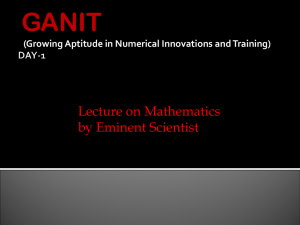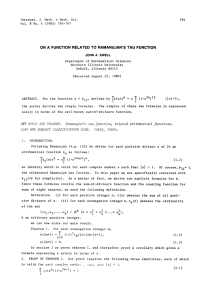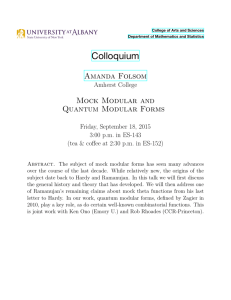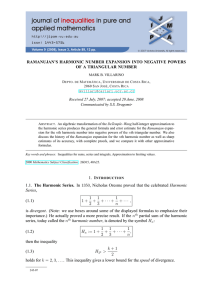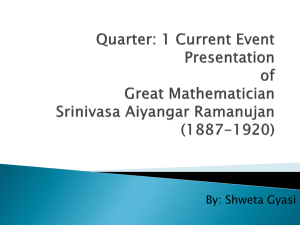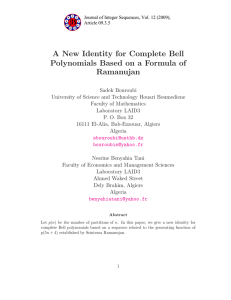RAMANUJAN’S HARMONIC NUMBER EXPANSION INTO NEGATIVE POWERS OF A TRIANGULAR NUMBER JJ
advertisement
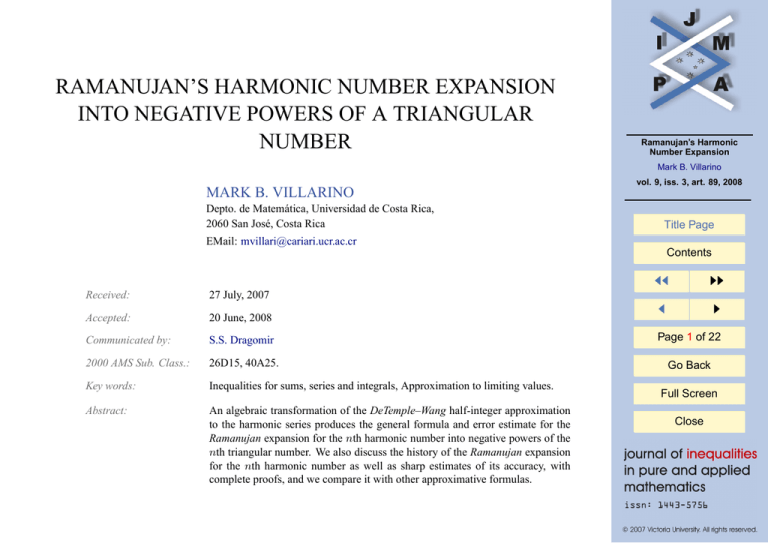
RAMANUJAN’S HARMONIC NUMBER EXPANSION
INTO NEGATIVE POWERS OF A TRIANGULAR
NUMBER
Ramanujan’s Harmonic
Number Expansion
Mark B. Villarino
MARK B. VILLARINO
Depto. de Matemática, Universidad de Costa Rica,
2060 San José, Costa Rica
vol. 9, iss. 3, art. 89, 2008
Title Page
EMail: mvillari@cariari.ucr.ac.cr
Contents
JJ
II
20 June, 2008
J
I
Communicated by:
S.S. Dragomir
Page 1 of 22
2000 AMS Sub. Class.:
26D15, 40A25.
Go Back
Key words:
Inequalities for sums, series and integrals, Approximation to limiting values.
Abstract:
An algebraic transformation of the DeTemple–Wang half-integer approximation
to the harmonic series produces the general formula and error estimate for the
Ramanujan expansion for the nth harmonic number into negative powers of the
nth triangular number. We also discuss the history of the Ramanujan expansion
for the nth harmonic number as well as sharp estimates of its accuracy, with
complete proofs, and we compare it with other approximative formulas.
Received:
27 July, 2007
Accepted:
Full Screen
Close
Contents
1
2
3
Introduction
1.1 The Harmonic Series . . . . . .
1.2 Ramanujan’s Formula . . . . . .
1.3 History of Ramanujan’s Formula
1.4 Sharp Error Estimates . . . . . .
.
.
.
.
3
3
4
6
8
Proof of the Sharp Error Estimates
2.1 A Few Lemmas . . . . . . . . . . . . . . . . . . . . . . . . . . . .
2.2 Proof for the Ramanujan–Lodge approximation . . . . . . . . . . .
2.3 Proof for the DeTemple–Wang Approximation . . . . . . . . . . . .
11
11
13
15
Proof of the general Ramanujan–Lodge expansion
17
.
.
.
.
.
.
.
.
.
.
.
.
.
.
.
.
.
.
.
.
.
.
.
.
.
.
.
.
.
.
.
.
.
.
.
.
.
.
.
.
.
.
.
.
.
.
.
.
.
.
.
.
.
.
.
.
.
.
.
.
.
.
.
.
.
.
.
.
.
.
.
.
Ramanujan’s Harmonic
Number Expansion
Mark B. Villarino
vol. 9, iss. 3, art. 89, 2008
Title Page
Contents
JJ
II
J
I
Page 2 of 22
Go Back
Full Screen
Close
1.
1.1.
Introduction
The Harmonic Series
In 1350, Nicholas Oresme proved that the celebrated Harmonic Series,
(1.1)
1+
1 1
1
+ + ··· + + ··· ,
2 3
n
is divergent. (Note: we use boxes around some of the displayed formulas to emphasize their importance.) He actually proved a more precise result. If the nth partial
sum of the harmonic series, today called the nth harmonic number, is denoted by the
symbol Hn :
(1.2)
Hn := 1 +
1 1
1
+ + ··· + ,
2 3
n
then the inequality
(1.3)
H 2k >
k+1
2
holds for k = 2, 3, . . . . This inequality gives a lower bound for the speed of divergence.
Almost four hundred years passed until Leonhard Euler, in 1755 [3] applied the
Euler–Maclaurin sum formula to find the famous standard Euler asymptotic expan-
Ramanujan’s Harmonic
Number Expansion
Mark B. Villarino
vol. 9, iss. 3, art. 89, 2008
Title Page
Contents
JJ
II
J
I
Page 3 of 22
Go Back
Full Screen
Close
sion for Hn ,
Hn :=
n
X
1
k=1
(1.4)
k
∼ ln n + γ +
= ln n + γ −
∞
X
Bk
k=1
nk
1
1
1
−
+
− [· · · ]
2
2n 12n
120n4
,
where Bk denotes the k th Bernoulli number and γ := 0.57721 · · · is Euler’s constant.
This gives a complete answer to the speed of divergence of Hn in powers of n1 .
Since then many mathematicians have contributed other approximative formulas
for Hn and have studied the rate of divergence. We will present a detailed study
of such a formula stated by Ramanujan, with complete proofs, as well as of some
related formulas.
1.2.
Ramanujan’s Formula
Entry 9 of Chapter 38 of B. Berndt’s edition of Ramanujan’s Notebooks [2, p. 521]
reads,
“Let m :=
infinity,
(1.5)
n(n+1)
,
2
where n is a positive integer. Then, as n approaches
n
X
1
k=1
1
1
1
1
1
1
∼ ln(2m) + γ +
−
+
−
+
2
3
4
k
2
12m 120m
630m
1680m
2310m5
−
191
29
2833
140051
+
−
+
− [· · · ].”
6
7
8
360360m
30030m
1166880m
17459442m9
We note that m := n(n+1)
is the nth triangular number, so that Ramanujan’s
2
expansion of Hn is into powers of the reciprocal of the nth triangular number.
Ramanujan’s Harmonic
Number Expansion
Mark B. Villarino
vol. 9, iss. 3, art. 89, 2008
Title Page
Contents
JJ
II
J
I
Page 4 of 22
Go Back
Full Screen
Close
Berndt’s proof simply verifies (as he himself explicitly notes) that Ramanujan’s
expansion coincides with the standard Euler expansion (1.4).
However, Berndt does not give the general formula for the coefficient of m1k in
Ramanujan’s expansion, nor does he prove that it is an asymptotic series in the sense
that the error in the value obtained by stopping at any particular stage in Ramanujan’s
series is less than the next term in the series. Indeed we have been unable to find any
error analysis of Ramanujan’s series.
We will prove the following theorem.
Ramanujan’s Harmonic
Number Expansion
Mark B. Villarino
Theorem 1.1. For any integer p ≥ 1 define
(
)
p X
p
(−1)p−1
Rp :=
1+
(−4)k B2k ( 21 )
(1.6)
2p · 8p
k
k=1
vol. 9, iss. 3, art. 89, 2008
Title Page
Contents
where B2k (x) is the Bernoulli polynomial of order 2k. Put
(1.7)
m :=
n(n + 1)
2
II
J
I
Page 5 of 22
where n is a positive integer. Then, for every integer r ≥ 1, there exists a Θr ,
0 < Θr < 1, for which the following equation is true:
r
(1.8)
JJ
X Rp
1 1
1
1
Rr+1
1 + + + · · · + = ln(2m) + γ +
+ Θr · r+1 .
p
2 3
n
2
m
m
p=1
We observe that the formula for Rp can be written symbolically as follows:
p
1 4B 2 − 1
(1.9)
Rp = −
,
2p
8
Go Back
Full Screen
Close
where we write B2m ( 12 ) in place of B 2m after carrying out the above expansion.
We will also trace the history of Ramanujan’s expansion as well and discuss the
relative accuracy of his approximation when compared to other approximative formulas proposed by mathematicians.
1.3.
History of Ramanujan’s Formula
In 1885, two years before Ramanujan was born, Cesàro [4] proved the following.
Theorem 1.2. For every positive integer n ≥ 1 there exists a number cn , 0 < cn < 1,
such that the following approximation is valid:
Hn =
1
cn
ln(2m) + γ +
.
2
12m
Ramanujan’s Harmonic
Number Expansion
Mark B. Villarino
vol. 9, iss. 3, art. 89, 2008
Title Page
Contents
This gives the first two terms of Ramanujan’s expansion, with an error term. The
method of proof, different from ours, does not lend itself to generalization. We
believe Cesàro’s paper to be the first appearance in the literature of Ramanujan’s
expansion.
Then, in 1904, Lodge, in a very interesting paper [8], which later mathematicians
inexplicably (in our opinion) ignored, proved a version of the following two results.
Theorem 1.3. For every positive integer n, define the quantity λn by the following
equation:
JJ
II
J
I
Page 6 of 22
Go Back
Full Screen
Close
(1.10)
1 1
1
1
1
1 + + + · · · + := ln(2m) + γ +
2 3
n
2
12m +
Then
0 < λn <
19
.
25200m3
6
5
+ λn .
In fact,
19
43
−
ρ
,
where
0
<
ρ
<
.
n
n
25200m3
84000m4
43
and 84000
are the best possible.
λn =
The constants
19
25200
Theorem 1.4. For every positive integer n, define the quantity Λn by the following
equation:
(1.11)
1+
1 1
1
1
1
+ + · · · + =: ln(2m) + γ +
.
2 3
n
2
12m + Λn
Ramanujan’s Harmonic
Number Expansion
Mark B. Villarino
vol. 9, iss. 3, art. 89, 2008
Then
19
13
δn
6
−
+
−
,
5 175m 250m2 m3
187969
where 0 < δn < 4042500
. The constants in the expansion of Λn all are the best
possible.
Λn =
These two theorems appeared, in much less precise form and with no error estimates, in Lodge [8]. Lodge gives some numerical examples of the error in the
approximative equation
1
1
Hn ≈ ln(2m) + γ +
2
12m + 65
in Theorem 1.3; he also presents the first two terms of Λn from Theorem 1.4. An
1
asymptotic error estimate for Theorem 1.3 (with the incorrect constant 150
instead
1
of 165 15 ) appears as Exercise 19 on page 460 in Bromwich [3].
19
Theorem 1.3 and Theorem 1.4 are immediate corollaries of Theorem 1.1.
The next appearance of the expansion of Hn , into powers of the reciprocal of the
1
nth triangular number, m = n(n+1)
, is Ramanujan’s own expansion (1.5).
2
Title Page
Contents
JJ
II
J
I
Page 7 of 22
Go Back
Full Screen
Close
1.4.
Sharp Error Estimates
Mathematicians have continued to offer alternate approximative formulas to Euler’s.
We cite the following formulas, which appear in order of increasing accuracy.
No.
1
Approximative Formula for Hn
ln n + γ +
1
2n
Type
overestimates
Asymptotic Error
Estimate
1
12n2
Ramanujan’s Harmonic
Number Expansion
Mark B. Villarino
vol. 9, iss. 3, art. 89, 2008
2
ln n + γ +
1
2n+ 13
underestimates
1
72n3
Title Page
p
3
ln
n(n + 1) + γ +
4
ln(n + 12 ) + γ +
1
6n(n+1)+ 65
1
24(n+ 12 )2 + 21
5
overestimates
1
165 15
[n(n+1)]3
19
overestimates
1
781
389 2071
(n+ 12 )6
Contents
JJ
II
J
I
Page 8 of 22
Formula 1 is the original Euler approximation, and it overestimates the true value
1
of Hn by terms of order 12n
2.
Formula 2 is the Tóth–Mare approximation, see [9], and it underestimates the
1
true value of Hn by terms of order 72n
3.
Formula 3 is the Ramanujan–Lodge approximation, and it overestimates the true
19
value of Hn by terms of order 3150[n(n+1)]
3 , see [10].
Formula 4 is the DeTemple–Wang approximation, and it overestimates the true
2071
value of Hn by terms of order 806400(n+
1 6 , see [6].
)
2
Go Back
Full Screen
Close
In 2003, Chao-Ping Chen and Feng Qi [5] gave a proof of the following sharp
form of the Tóth–Mare approximation.
Theorem 1.5. For any natural number n ≥ 1, the following inequality is valid:
(1.12)
1
2n +
1
1−γ
−2
≤ Hn − ln n − γ <
1
The constants 1−γ
− 2 = .3652721 · · · and
holds only for n = 1.
1
3
1
2n +
1
3
.
Ramanujan’s Harmonic
Number Expansion
are the best possible, and equality
vol. 9, iss. 3, art. 89, 2008
The first statement of this theorem had been announced ten years earlier by the
editors of the “Problems” section of the American Mathematical Monthly, 99 (1992),
p. 685, as part of a commentary on the solution of Problem E 3432, but they did not
publish the proof. So, the first published proof is apparently that of Chen and Qi.
In this paper we will prove new and sharp forms of the Ramanujan–Lodge approximation and the DeTemple–Wang approximation.
Theorem 1.6 (Ramanujan–Lodge). For any natural number n ≥ 1, the following
inequality is valid:
1
6n(n + 1) +
(1.13)
Mark B. Villarino
Title Page
Contents
JJ
II
J
I
Page 9 of 22
Go Back
6
5
< Hn − ln
≤
p
n(n + 1) − γ
1
6n(n + 1) +
1 √
1−γ−ln 2
1 ln 2 √
The constants 1−γ−ln
− 12 = 1.12150934 · · · and
2
equality holds only for n = 1.
6
5
− 12
Full Screen
.
are the best possible, and
Close
Theorem 1.7 (DeTemple–Wang). For any natural number n ≥ 1, the following
inequality is valid:
1
24(n +
(1.14)
1 2
)
2
+
21
5
≤ Hn − ln(n + 12 ) − γ
<
24(n +
1 2
)
2
1
.
+ 1−ln13 −γ − 54
The constants 1−ln13 −γ − 54 = 3.73929752 · · · and
2
equality holds only for n = 1.
2
21
5
are the best possible, and
DeTemple and Wang never stated this approximation to Hn explicitly. They gave
the asymptotic expansion of Hn , cited below in Proposition 3.1, and we developed
the corresponding approximative formulas given above.
All three theorems are corollaries of the following stronger theorem.
Theorem 1.8. For any natural number n ≥ 1, define fn , λn , and dn by
1
Hn =: ln n + γ +
2n + fn
p
1
(1.15)
=: ln n(n + 1) + γ +
6n(n + 1) + λn
1
(1.16)
=: ln(n + 12 ) + γ +
,
24(n + 12 )2 + dn
respectively. Then for any natural number n ≥ 1 the sequence {fn } is monotonically decreasing while the sequences {λn } and {dn } are monotonically increasing.
Chen and Qi [5] proved that the sequence {fn } decreases monotonically. In this
paper we will use their techniques to prove the monotonicity of the sequences {λn }
and {dn }.
Ramanujan’s Harmonic
Number Expansion
Mark B. Villarino
vol. 9, iss. 3, art. 89, 2008
Title Page
Contents
JJ
II
J
I
Page 10 of 22
Go Back
Full Screen
Close
2.
2.1.
Proof of the Sharp Error Estimates
A Few Lemmas
Our proof is based on inequalities satisfied by the digamma function Ψ(x),
(2.1)
∞
X
d
Γ0 (x)
1
1
Ψ(x) :=
ln Γ(x) ≡
≡ −γ − + x
,
dx
Γ(x)
x
n(x + n)
n=1
Ramanujan’s Harmonic
Number Expansion
Mark B. Villarino
which is the generalization of Hn to the real variable x since Ψ(x) and Hn satisfy
the equation [1, (6.3.2), p. 258]:
vol. 9, iss. 3, art. 89, 2008
Ψ(n + 1) = Hn − γ.
Title Page
Lemma 2.1. For every x > 0 there exist numbers θx and Θx , with 0 < θx < 1 and
0 < Θx < 1, for which the following equations are true:
Contents
(2.2)
1
1
1
1
1
Ψ(x + 1) = ln x +
(2.3)
−
+
−
+
θx ,
2
4
6
2x 12x
120x
252x
240x8
1
1
1
1
1
1
(2.4)
Ψ0 (x + 1) = − 2 + 3 −
+
−
Θx .
5
7
x 2x
6x
30x
42x
30x9
Proof. Both formulas are well known. See, for example, [7, pp. 124–125].
Lemma 2.2. The following inequalities are true for x > 0:
(2.5)
1
1
4
1
10
1
− 3+
− 5+
− 7
2
4
6
3x
3x
15x
5x
63x
7x
< 2Ψ(x + 1) − ln{x(x + 1)}
1
1
4
1
10
< 2− 3+
− 5+
,
4
3x
3x
15x
5x
63x6
JJ
II
J
I
Page 11 of 22
Go Back
Full Screen
Close
2
1
16
1
20
1
− 4+
− 6+
− 8
3
5
7
3x
4x
15x
x
21x
x
1
1
< +
− 2Ψ0 (x + 1)
x x+1
2
1
16
1
20
< 3− 4+
−
+
.
3x
4x
15x5 x6 21x7
Proof. The inequalities (2.5) are an immediate consequence of (2.3) and the Taylor
expansion of
1
1
1
1
1
− ln x(x + 1) = −2 ln x − ln 1 +
= 2 ln
− + 2 − 3 + [· · · ]
x
x
x 2x
3x
(2.6)
which is an alternating series with the property that its sum is bracketed by two
consecutive partial sums.
For (2.6) we start with (2.4). We conclude that
1
1
1
1
1
1
1
1
− 3+
−
< − Ψ0 (x + 1) < 2 − 3 +
.
2
5
7
2x
6x
30x
36x
x
2x
6x
30x5
Now we multiply all three components of the inequality by 2 and add
them.
1
x+1
−
1
x
to
Ramanujan’s Harmonic
Number Expansion
Mark B. Villarino
vol. 9, iss. 3, art. 89, 2008
Title Page
Contents
JJ
II
J
I
Page 12 of 22
Go Back
Lemma 2.3. The following inequalities are true for x > 0:
1
1
1
1
1
1
+ 2− 3+
−
1 −
5
6x
30x
42x7
(x + 2 ) x 2x
1
<
− Ψ0 (x + 1)
x + 12
1
1
1
1
1
<
+ 2− 3+
,
1 −
6x
30x5
(x + 2 ) x 2x
Full Screen
Close
1
1
23
1
11
1
−
+
−
−
−
2
3
4
5
6
24x
24x
960x
160x
8064x
896x7
1
< Ψ(x + 1) − ln(x + 2 )
1
1
23
1
11
1
143
<
−
+
−
−
−
+
.
2
3
4
5
6
7
24x
24x
960x
160x
8064x
896x
30720x8
Proof. Similar to the proof of Lemma 2.2.
2.2.
Proof for the Ramanujan–Lodge approximation
Proof of Theorem 1.8 for {λn }. We solve (1.15) for λn and use (2.2) to obtain
λn =
1
Ψ(n + 1) − ln
p
n(n + 1)
− 6n(n + 1).
Ramanujan’s Harmonic
Number Expansion
Mark B. Villarino
vol. 9, iss. 3, art. 89, 2008
Title Page
Contents
Define
1
− 3x(x + 1),
2Ψ(x + 1) − ln x(x + 1)
for all x > 0. Observe that 2Λn = λn .
JJ
II
J
I
We will show that that the derivative Λ0x > 0 for x > 28. Computing the derivative we obtain
Page 13 of 22
Λx :=
Λ0x =
1
x
1
x+1
0
+
− Ψ (x + 1)
− (6x + 3),
{2Ψ(x + 1) − ln x(x + 1)}2
and therefore
{2Ψ(x + 1) − ln x(x + 1)}2 Λ0x
1
1
= +
− Ψ0 (x + 1) − (6x + 3){2Ψ(x + 1) − ln x(x + 1)}2 .
x x+1
Go Back
Full Screen
Close
By Lemma 2.2, this is greater than
2
1
16
1
20
1
− 4+
− 6+
− 8
3
5
7
3x
4x
15x
x
21x
x
2
1
1
4
1
10
− (6x + 3)
−
+
−
+
3x2 3x3 15x4 5x5 63x6
798x5 − 21693x4 − 3654x3 + 231x2 + 1300x − 2500
=
33075x12
4
(x − 28)(798x + 651x3 + 14574x2 + 408303x + 11433784) + 320143452
=
33075x12
(by the remainder theorem), which is obviously positive for x > 28. Thus, the
sequence {Λn }, n ≥ 29, is strictly increasing. Therefore, so is the sequence {λn }.
For n = 1, 2, 3, . . . , 28, we compute λn directly:
λ1
λ5
λ9
λ13
λ17
λ21
λ25
= 1.1215093
= 1.1929804
= 1.1976125
= 1.1988131
= 1.1992926
= 1.1995310
= 1.1996664
λ2
λ6
λ10
λ14
λ18
λ22
λ26
= 1.1683646
= 1.1949431
= 1.1980429
= 1.1989707
= 1.1993668
= 1.1995717
= 1.1996911
λ3
λ7
λ11
λ15
λ19
λ23
λ27
= 1.1831718
= 1.1961868
= 1.1983668
= 1.1990988
= 1.1994300
= 1.1996073
= 1.1997131
λ4
λ8
λ12
λ16
λ20
λ24
λ28
= 1.1896217
= 1.1970233
= 1.1986165
= 1.1992045
= 1.1994842
= 1.1996387
= 1.1997329.
Therefore, the sequence {λn }, n ≥ 1, is a strictly increasing sequence.
Moreover, in Theorem 1.3, we proved that
λn =
6
− ∆n ,
5
Ramanujan’s Harmonic
Number Expansion
Mark B. Villarino
vol. 9, iss. 3, art. 89, 2008
Title Page
Contents
JJ
II
J
I
Page 14 of 22
Go Back
Full Screen
Close
where 0 < ∆n <
38
.
175n(n+1)
Therefore
6
lim λn = .
n→∞
5
2.3.
Proof for the DeTemple–Wang Approximation
Ramanujan’s Harmonic
Number Expansion
Proof of Theorem 1.8 for {dn }. Following the idea in the proof of the Lodge–Ramanujan
approximation, we solve (1.16) for dn and define the corresponding real-variable
version. Let
1
− 24(x + 12 )2 .
dx :=
Ψ(x + 1) − ln(x + 21 )
We compute the derivative, ask when is it positive, clear the denominator and observe
that we have to solve the inequality:
2
1
0
1
1
> 0.
1 − Ψ (x + 1) − 48(x + 2 ) Ψ(x + 1) − ln(x + 2 )
x+ 2
Mark B. Villarino
vol. 9, iss. 3, art. 89, 2008
Title Page
Contents
By Lemma 2.3, the left hand side of this inequality is
II
J
I
Page 15 of 22
1
>
x+
1
1
1
1
1
+ 2− 3+
−
1 −
x 2x
6x
30x5 42x7
2
2
1
23
1
11
1
143
1
1
−
+
−
−
−
+
− 48(x + 2 )
24x2 24x3 960x4 160x5 8064x6 896x7 30720x8
Go Back
Full Screen
Close
for all x > 0. This last quantity is equal to
(−9018009 − 31747716x − 14007876x2 + 59313792x3 + 11454272x4 − 129239296x5
+ 119566592x6 + 65630208x7 − 701008896x8 − 534417408x9 + 178139136x10 )
17340825600x16 (1 + 2x)
JJ
.
The denominator is evidently positive for x > 0 and the numerator can be written in
the form
p(x)(x − 4) + r,
where
p(x) = 548963242092 + 137248747452x + 34315688832x2
Ramanujan’s Harmonic
Number Expansion
+ 8564093760x3 + 2138159872x4 + 566849792x5 + 111820800x6
+ 11547648x7 + 178139136x8 + 178139136x9 ,
Mark B. Villarino
vol. 9, iss. 3, art. 89, 2008
with remainder r = 2195843950359.
Therefore, the numerator is clearly positive for x > 4, and therefore, the derivative dx0 is also positive for x > 4. Finally,
d1
d2
d3
d4
= 3.73929752 · · ·
= 4.08925414 · · ·
= 4.13081174 · · ·
= 4.15288035 · · ·
Title Page
Contents
,
,
,
.
JJ
II
J
I
Page 16 of 22
Therefore {dn } is an increasing sequence for n ≥ 1.
Now, if we expand the formula for dn into an asymptotic series in powers of
we obtain
1400
21
−
dn ∼
+ ···
5
2071(n + 12 )
1
n+ 12
(this is an immediate consequence of Proposition 3.1 below) and we conclude that
lim dn =
n→∞
21
.
5
,
Go Back
Full Screen
Close
3.
Proof of the general Ramanujan–Lodge expansion
Proof of Theorem 1.6. Our proof is founded on the half-integer approximation to Hn
due to DeTemple and Wang [6]:
Proposition 3.1. For any positive integer r there exists a θr , with 0 < θr < 1, for
which the following equation is true:
Hn = ln(n + 21 ) + γ +
(3.1)
r
X
p=1
Dr+1
Dp
,
1 2p + θr ·
(n + 12 )2r+2
(n + 2 )
Ramanujan’s Harmonic
Number Expansion
Mark B. Villarino
vol. 9, iss. 3, art. 89, 2008
where
Dp := −
(3.2)
B2p ( 12 )
,
2p
and where B2p (x) is the Bernoulli polynomial of order 2p.
Since (n + 12 )2 = 2m + 14 , we obtain
r
X
p=1
−p
r
r
X
X
Dp
1
Dp
Dp
=
=
1+
1 p
(2m)p
8m
(n + 12 )2p
(2m)p 1 + 8m
p=1
p=1
r
∞
X
Dp X −p
1
=
p
k
(2m) k=0 k 8 mk
p=1
r
∞
X
Dp X
1
1
k k+p−1
=
(−1)
· p+k
p
k
2 k=0
k
8 m
p=1
p−1
r X
X
1
1
Ds
p−s p − 1
(−1)
· p + Er .
=
s
p−s
2
p−s 8
m
p=1 s=0
Title Page
Contents
JJ
II
J
I
Page 17 of 22
Go Back
Full Screen
Close
Substituting the right hand side of the last equation into the right hand side of
(3.1) we obtain
( p−1
)
r
X
X Ds
p−1 1
1
(3.3) Hn = ln(n + 12 ) + γ +
(−1)p−s
· p
s
p−s
2
p−s 8
m
s=0
p=1
+ Er + θr ·
Dr+1
.
(n + 12 )2r+2
Moreover,
Ramanujan’s Harmonic
Number Expansion
Mark B. Villarino
vol. 9, iss. 3, art. 89, 2008
ln(n + 12 )2
1
= ln(2m + 41 )
2
2
1
1
1
= ln(2m) + ln 1 +
2
2
8m
∞
1
1
1X
= ln(2m) +
(−1)l−1 l l .
2
2 l=1
l8 m
ln(n + 12 ) =
Substituting the right-hand side of this last equation into (3.3), we obtain
Contents
JJ
II
J
I
Page 18 of 22
Go Back
r
1
1X
1
Hn = ln(2m) +
(−1)l−1 l l
2
2 l=1
l8 m
( p−1
)
r
X
X Ds
1
1
p−s p − 1
(−1)
· p
+γ+
s
p−s
2
p−s 8
m
p=1
s=0
+ r + Er + θr ·
Title Page
Dr+1
(n + 12 )2r+2
Full Screen
Close
=
1
ln(2m) + γ +
2
r
X
(
p=1
+ r + Er + θr ·
(−1)p−1
1
+
2p 8p
p−1
X
Ds
s=0
2s
(−1)p−s
)
p−1 1
1
· p
p−s
p−s 8
m
Dr+1
.
(n + 12 )2r+2
Therefore, we have obtained Ramanujan’s expansion in powers of
coefficient of m1p is
1
,
m
and the
Ramanujan’s Harmonic
Number Expansion
Mark B. Villarino
p−1
Rp = (−1)p−1
(3.4)
X Ds
1
+
(−1)p−s
p
s
2p 8
2
s=0
p−1 1
.
p − s 8p−s
vol. 9, iss. 3, art. 89, 2008
Title Page
But,
B2s ( 12 )/2s
1
1
Ds
p−s p − 1
p−s p − 1
(−1)
=−
(−1)
s
p−s
s
p−s
2
p−s 8
2
p−s 8
1 1
p−s−1 B2s ( 2 ) p − 1
= (−1)
,
s
p−s
2s 2
p−s 8
and therefore
Contents
JJ
II
J
I
Page 19 of 22
Go Back
p−1
X
Ds
1
p−1 1
p−s p − 1
Rp = (−1)
+
(−1)
p
s
p−s
2p 8
2
p−s 8
s=0
p−1
1 X
1
p−1 1
p−s−1 B2s ( 2 ) p − 1
= (−1)
+
(−1)
p
s
p−s
2p 8
2s 2
p−s 8
s=0
p
1 X
1
1
s B2s ( 2 ) p − 1
p−1
+
(−1)
= (−1)
2p 8p s=1
2s 2s p − s 8p−s
Full Screen
Close
p
1
X
1
1
s B2s ( 2 ) 1 p
= (−1)
+
·
(−1)
2p 8p s=1
2 · 2s p s 8p−s
p X
(−1)p−1
p
s
1
=
1+
(−4) B2s ( 2 ) .
2p 8p
s
s=1
p−1
Therefore, the formula for Hn takes the form
(
)
p r
X
X
p
1
(−1)p−1
1
(3.5) Hn = ln(2m) + γ +
1+
(−4)s B2s ( 12 ) · p + Er ,
p
2
2p 8
s
m
p=1
s=1
where
Ramanujan’s Harmonic
Number Expansion
Mark B. Villarino
vol. 9, iss. 3, art. 89, 2008
Title Page
Er := r + Er + θr ·
(3.6)
Dr+1
.
(n + 12 )2r+2
We see that (3.5) is the Ramanujan expansion with the general formula as given
in the statement of the theorem, while (3.6) is a form of the error term.
We will now estimate the error, (3.6).
To do so, we will use the fact that the sum of a convergent alternating series,
whose terms (taken with positive sign) decrease monotonically to zero, is equal to
any partial sum plus a positive fraction of the first neglected term (with sign).
Thus,
∞
X
1
1
r
(−1)l−1
r :=
=
α
(−1)
,
r
l ml
r+1 mr+1
2l
8
2(r
+
1)8
l=r+1
where 0 < αr < 1.
Moreover,
Contents
JJ
II
J
I
Page 20 of 22
Go Back
Full Screen
Close
∞
∞
1
1
D2 X
1
D4 X
1
k k
k k+1
Er := 1
(−1)
· 1+k + 2
(−1)
· 2+k + · · ·
k
k
k 8 m
k
2 k=r
2 k=r−1
8 m
∞
1
D2r X
1
D2r+2
k k+r−1
+ r
(−1)
· r+k + θr ·
k
1 r+1
k
2 k=1
8 m
(2m)r+1 1 + 8m
D2
1
D4
r
1
r r
r−1
+ δ2 2 (−1)
+ ···
= δ1 1 (−1)
r
r−1
2
r 8
2
r−1 8
1
D2r+2
1
D2r
1 r
+ δr+1 r+1
+ δr r (−1)
1
2
1 8
2
mr+1
D2
1
D4
r
1
r r
r−1
= ∆r
(−1)
+
(−1)
+ ···
21
r 8r
22
r − 1 8r−1
D2r
1
D2r+2
1
1 r
+ r (−1)
+ r+1
,
1
2
1 8
2
mr+1
where 0 < δk < 1 for k = 1, 2, . . . , r + 1 and 0 < ∆r < 1. Thus, the error is
r+1
X
D2q
r
1
1
1
r−q+1
r
Er = Θr · (−1)
+
(−1)
(r+1)
q
r−q+1
2(r + 1)8
2
r−q+1 8
mr+1
q=1
= Θr · Rr+1 ,
by (1.6), where 0 < Θr < 1, which is of the required form. This completes the
proof.
The origin of Ramanujan’s formula is mysterious. Berndt notes that in his remarks. Our analysis of it is a posteriori and, although it is full and complete, it
does not shed light on how Ramanujan came to think of his expansion. It would
also be interesting to develop an expansion for n! into powers of m, a new Stirling
expansion, as it were.
Ramanujan’s Harmonic
Number Expansion
Mark B. Villarino
vol. 9, iss. 3, art. 89, 2008
Title Page
Contents
JJ
II
J
I
Page 21 of 22
Go Back
Full Screen
Close
References
[1] M. ABRAMOWITZ AND I.A. STEGUN, Handbook of Mathematical Functions, Dover, New York, 1965.
[2] B. BERNDT, Ramanujan’s Notebooks, Volume 5, Springer, New York, 1998.
[3] T.J. l’A. BROMWICH, An Introduction to the Theory of Infinite Series,
Chelsea, New York, 1991.
[4] E. CESÀRO, Sur la serie harmonique, Nouvelles Annales de Mathématiques
(3) 4 (1885), 295–296.
[5] Ch.-P. CHEN AND F. QI, The best bounds of the nth harmonic number, Global
J. Math. and Math. Sci., 2 (2006), accepted. The best lower and upper bounds
of harmonic sequence, RGMIA Research Report Collection, 6(2) (2003), Art.
14. The best bounds of harmonic sequence, arXiv:math.CA/0306233, Jiaozuo,
Henan, China, 2003.
[6] D. DeTEMPLE AND S.-H. WANG, Half-integer approximations for the partial
sums of the harmonic series, J. Math. Anal. Appl., 160 (1991), 149–156.
[7] J. EDWARDS, A Treatise on the Integral Calculus, Vol. 2, Chelsea, N.Y., 1955.
[8] A. LODGE, An approximate expression for the value of 1 + 12 + 13 + · · · + 1r ,
Messenger of Mathematics, 30 (1904), 103–107.
[9] L. TÓTH AND S. MARE, Problem E 3432, Amer. Math. Monthly, 98 (1991),
264.
[10] M. VILLARINO, Ramanujan’s approximation to the nth partial sum of the
harmonic series, arXiv:math.CA/0402354, San José, 2004.
[11] M. VILLARINO, Best bounds for the harmonic numbers,
arXiv:math.CA/0510585, San José, 2005.
Ramanujan’s Harmonic
Number Expansion
Mark B. Villarino
vol. 9, iss. 3, art. 89, 2008
Title Page
Contents
JJ
II
J
I
Page 22 of 22
Go Back
Full Screen
Close
